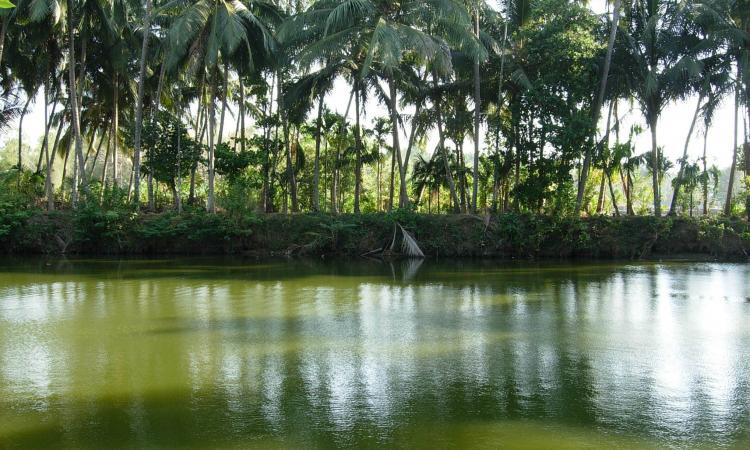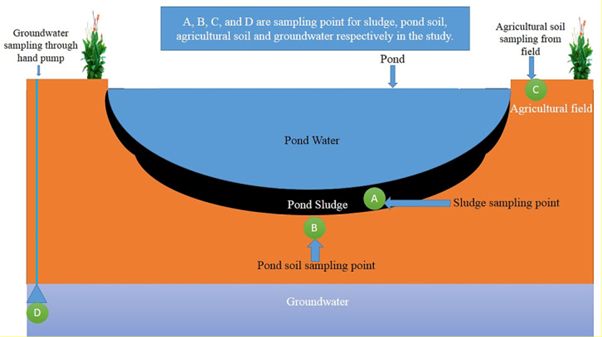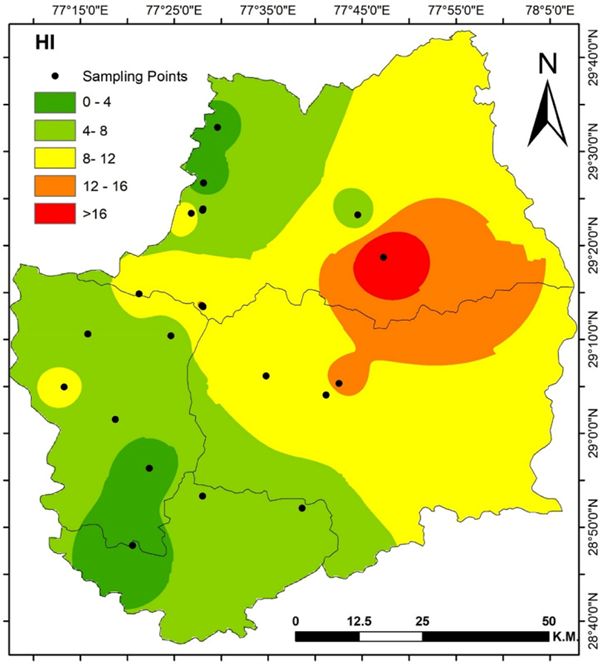
Ponds are increasingly getting polluted mainly due to the discharge of wastewater from residential areas, sewage outlets, solid waste dump sites, livestock rearing sites (e.g., dairy, poultry), and fertilizers and pesticides from farmers’ fields.
The sludge accumulated in these water bodies may contain appreciable amounts of toxic metals that may leach to the groundwater and long-term use of contaminated water, either directly from these water bodies or the nearby handpumps or tubewells, can cause serious threats to human health.
The recent paper ‘Appraisal of heavy metal pollution in the water resources of Western Uttar Pradesh, India and associated risks’ by V C Goyal et al in the journal Environmental Advances investigate heavy metal contamination in the pond sludge, pond soil, and groundwater at villages in Western Uttar Pradesh.
Heavy metal pollution brings toxicity, has implications for life, and leads to environmental risk with its poisonous, long-latency, and accumulative characteristics.
This study investigated nine heavy metal (Pb, Cu, Ni, Zn, Cr, Cd, Fe, As, and Mn) contamination in the water bodies in 21 villages in the Muzaffarnagar, Meerut, Ghaziabad, and Baghpat districts of Western Uttar Pradesh. The study provides a sound case for examining the toxic metal accumulation in terrestrial water bodies.
The selected ponds are small to moderate-size water bodies, with average depth varying between 2m to 5m and water storage capacity varying between 8,000 and 46,000 m3. The ponds receive wastewater from nearby habitation and stormwater from the surrounding upland areas during the monsoon. Wastewater generated from households in the catchment area of a pond reaches the pond through naturally defined channels.
The majority of ponds are surrounded by rural habitation and all kinds of waste material, including grit, silt, crop residues, dairy waste, etc. enter the ponds. Due to utter neglect by the community and local authorities, no desilting or desludging was carried out in these ponds for many decades and the ponds became waste dumping sites.
In a few ponds, runoff from the nearby agricultural fields also brings residues of fertilizers, pesticides, etc. All ponds were categorized as hypertrophic. Relatively higher pH, high BOD and low DO in these ponds established the impact of human and animal activities around the ponds.

The mean concentration of Pb, Cu, Ni, Zn, Cr, Cd, Fe, As and Mn in pond sludge was 0.64, 0.53, 0.94, 3.34, 0.62, 0.010, 151.70, 0.32, and 35.02 mg/kg sludge, respectively, and in pond soil the concentration of Pb, Cu, Ni, Zn, Cr, Cd, Fe, As and Mn were 0.13, 0.45, 1.21, 0.82, 3.22, 0.06, 2055.04, 0.16, and 457.84 mg/kg soil, respectively.
In this study, the geo-accumulation index, ecological risk assessment, and human health hazard index were used for assessing the toxicity in pond ecosystems and human health hazards to consumers in terms of heavy metal presence. Being land-locked and continuously receiving wastewater from the nearby villages, the ponds became a storehouse of metal toxicity in the accumulated sludge.
The geo-accumulation index (I-geo) in the pond sludge and soil ranged from unpolluted to extremely polluted. The average I-geo values of metals in pond sludge and soil were in order Pb (4.93) > Zn (4.36) > Ni (0.70) > Cu (0.40) > As (0.32) > Cd (-0.58) > Cr (-1.96) > Fe (-4.24) > Mn (-5.28) and Cu (2.76) > Cr (2.35) > Pb (2.17) > Ni (2.01) > Zn (1.53) > Cd (-0.22) > Fe (-0.49) > As (-0.78) > Mn (-1.41), respectively.
The combined ecological risk due to metal accumulation extended from low risk to very high risk. The groundwater samples were observed to non-comply with the drinking water standards due to high levels of Pb, Cu, Ni, Fe, and Mn, and the human health hazard index ranged from 0.831 to 21.76.
Lead concentration was observed significantly in sludge samples, indicating that it may have been deposited recently and not leached to the pond soil or groundwater below. In these types of shallow water bodies, the entry of nutrients and other pollutants is received in boom-and-bust cycle mode, resulting in changes in the environmental conditions near the liquid and solid interface and mobilization of accumulated metals in the bottom sludge.

The accumulated metals in the pond sludge and soil resulted in cumulative ERI values ranging from 59.01 to 2951 (Average: 810) with 53.11 to 3311 (Average: 740), respectively. The sludge was observed to be more contaminated in comparison to the soil beneath. The heavy metals in the groundwater indicated around 95% of samples can pose adverse health effects on the consumers with Fe, Mn, and Pb as the major contributors.
The study sites are also surrounded by industrial areas of Greater Noida, Ghaziabad and Meerut (Uttar Pradesh), and Haridwar (Uttarakhand) and atmospheric deposition from these sites may be the possible source for Pb and other heavy metals. I-geo of sludge and pond soil samples showed the potential of metals to contaminate the particular area.
India is poised in a big way to rejuvenate small water bodies such as lakes and ponds. Most of these lakes and ponds have not been restored for many decades, and have accumulated heavy metals from varied sources. With time, and finding favourable conditions, heavy metals may leach into the groundwater thereby making it unfit for drinking purposes.
However, if not unduly contaminated, the sludge deposited in these water bodies can be a potential by-product for the nearby users (e.g., farmers). Monitoring toxicity from heavy metals and other contaminants in lakes and ponds is of utmost importance since these water bodies are considered the lifeline of human and livestock survival, especially in rural areas.
This study highlights the value of baseline monitoring and provides a sound case for examining the pond ecosystem for heavy metal toxicity before and during the rejuvenation of such water bodies in India and other sub-tropical countries.
The study presents a methodology for assessment of the accumulation of heavy metals in the sludge and soil in a pond ecosystem, and their potential to contaminate the local groundwater and impact human health.
The study is also expected to highlight the utility of the sludge from water bodies as a component of the circular economy, to be gainfully utilized by the nearby users.
/articles/pond-water-reuse-circular-economy-perspective